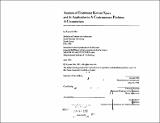Analysis of traditional Korean space and its application to a contemporary problem : a crematorium
Author(s)
Min, Kyuam
DownloadFull printable version (18.65Mb)
Other Contributors
Massachusetts Institute of Technology. Dept. of Architecture.
Advisor
Thomas Chastain.
Terms of use
Metadata
Show full item recordAbstract
This is more of an experimental design thesis rather than a theoretical research-oriented thesis on the history of Korean Architecture. Ultimately, a design of a concrete building, a crematorium, will be the final product of this thesis and will serve as a vehicle with which to experiment with my ideas in the design process. There is a strong driving force in this thesis: the aspiration to interpret the architecture of my ancestors with a fresh eye - in light of spatial organization. Thus, it was a necessary first step to visit a few historical buildings to experience the spaces themselves, following with an analysis of the plan afterwards. Throughout my own study, some assumptions were drawn as design guid~lines for the design of a crematorium. The critical issue of this design thesis centers on the evolution of 'Non-diagrammatic Space' from 'Diagrammatic Space' in the history of Korean architecture. Designing a building has been thought a complex process which relates political, economical, and social factors at the same time. But, though we know this intuitively, a design methodologist recently proved that most designs are generated not by listing all constraints but by starting with a 'prime generator'. In this context. the diagrammatic Korean temples are good illustrations of the 'Prime Generator'. But my main concern lies in ideas that cannot be easily explained by the notion of prime generator in the non-diagrammatic temples, which were the outgrowth of deep contemplation and a process of trial and error through hundreds of years.
Description
Thesis (M. Arch)--Massachusetts Institute of Technology, Dept. of Architecture, 1991. Includes bibliographical references (p. 126-127).
Date issued
1991Department
Massachusetts Institute of Technology. Department of ArchitecturePublisher
Massachusetts Institute of Technology
Keywords
Architecture.